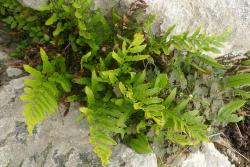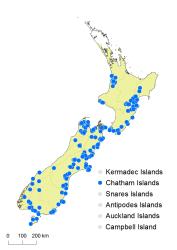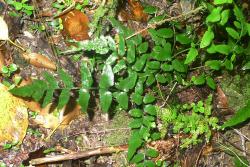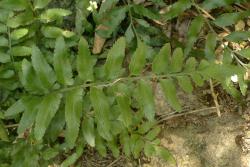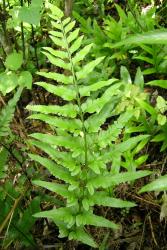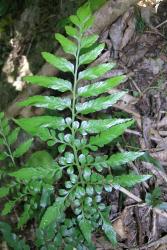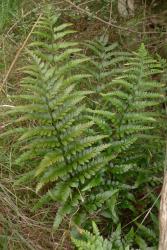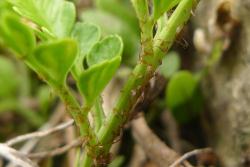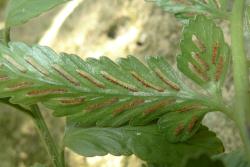- Taxon
- Gallery
- ≡ Asplenium lucidum var. lyallii Hook.f., Bot. Antarct. Voy. II (Fl. Nov.-Zel.) Part II, 33, t. 77 (1854)
- ≡ Asplenium obtusatum var. lyallii (Hook.f.) G.M.Thomson, Ferns New Zealand 74 (1882)
- = Asplenium triste Raoul, Ann. Sci. Nat., Bot. sér. 3, 2: 115 (1844) nom. illeg., non Asplenium triste Kaulf. 1824
- ≡ Asplenium bulbiferum var. triste (Raoul) Hook.f., Bot. Antarct. Voy. II (Fl. Nov.-Zel.) Part II, 34 (1854) nom. illeg.
- = Asplenium anomodum Colenso, Trans. & Proc. New Zealand Inst. 15: 309 (1883)
- ≡ Asplenium lucidum var. anomodum (Colenso) Cheeseman, Man. New Zealand Fl. 991 (1906)
- ≡ Asplenium obtusatum var. anomodum (Colenso) Domin, Biblioth. Bot. 20(85): 101 (1913)
Terrestrial or rupestral ferns. Rhizomes erect or short-creeping, bearing scales. Rhizome scales narrowly ovate, 8–25 mm long, 1–4.5 mm wide, brown, clathrate. Fronds 12–900 or rarely up to 1160 mm long. Stipes 4–400 mm long, pale brown abaxially and proximally, green adaxially and distally, bearing abundant narrowly ovate scales with filiform apices. Rachises green or sometimes brown abaxially, bearing abundant scales. Laminae 1–2-pinnate, narrowly ovate or ovate or elliptic, narrowed to a short pinnatifid or rarely undivided terminal segment with serrate margins similar to or more deeply incised than the primary pinnae; laminae 8–550 or rarely to 770 mm long, 5–230 mm wide, dark shiny green on adaxial surface and paler on abaxial surface or dull grey-green on both surfaces, herbaceous or coriaceous, bearing scales abaxially and sometimes adaxially, lacking hairs. Primary pinnae in 1–18 pairs below an undivided or pinnatifid apical segment, not overlapping; proximal pinnae ovate or narrowly ovate, those at mid-lamina narrowly ovate or narrowly oblong; the longest pinnae at or below the middle, 2–155 mm long, 1.5–60 mm wide; pinna apices obtuse or acute or acuminate, margins serrate, bases stalked; proximal pinnae bearing 1–6 pairs of secondary pinnae in the proximal half, or partially lobed or divided acroscopically, or occasionally not divided or lobed (on smallest fronds). Secondary pinnae ovate to elliptic, the longest 7–45 mm long, 4–16 or rarely up to 25 mm wide; apices obtuse, margins entire or serrate, bases stalked. Sori away from margins; indusia 3–14 mm long or rarely only 1 mm long in very small plants, straight; free margins of indusia entire. Mean spore size 40–54 μm long, 27–35 μm wide; perispores prominently winged and ridged.
Asplenium lyallii is an extremely variable species showing a wide range of frond size, colour and dissection. Plants growing in sheltered lowland habitats tend to produce large 2-pinnate fronds with dark glossy-green adaxial surfaces, whereas plants in exposed situations at high altitudes have much smaller 1-pinnate fronds that are dull grey-green on both surfaces. Usually the proximal pinnae are at least lobed or divided acroscopically, but in very small plants the pinnae can be undivided and lacking lobes. Small 1-pinnate fronds can be confused with A. lepidotum or small fronds of A. oblongifolium and A. obtusatum, but A. lyallii has larger spores than the other species. The stipe scales of A. oblongifolium are also narrower, with longer filiform apices, and scales are absent from the adaxial pinna surfaces. Plants of A. obtusatum have generally thicker fronds and are strictly coastal in habitat.
North Island: Auckland, Volcanic Plateau, Gisborne, Taranaki, Southern North Island.
South Island: Western Nelson, Sounds-Nelson, Marlborough, Westland, Canterbury, Otago, Southland, Fiordland.
Chatham Islands, Stewart Island.
Altitudinal range: 0–1400 m.
Asplenium lyallii occurs in the North Island on the west coast from Mt Karioi to south Taranaki, and on the eastern side of the island from the Gisborne and Hawke’s Bay ranges through the Ruahine Ranges and along the east coast to Wellington. It grows in coastal, lowland, montane, and subalpine areas from near sea level up to 1300 m on Mt Maungapōhatu, Gisborne. In the South Island it is largely confined to eastern districts, extending from north-west Nelson through Marlborough, Canterbury, coastal Otago and Southland into Fiordland and south Westland. It occurs in coastal, lowland, montane, and subalpine areas, ranging from sea level up to 1400 m in north-west Nelson, and also extends to Stewart Island and the Chatham Islands.
There are doubtful records from Northland, which need confirmation. One, which is definitely a specimen of A. lyallii, was said to be collected from Butler Bay, Mangōnui (WELT P009970) but grown on in cultivation and therefore possibly confused with another collection. The second came from Puketi Forest (AK 307201) but is sterile and could possibly be a hybrid.
Asplenium lyallii is a terrestrial fern found frequently on limestone, marble, or calcareous mudstone or sandstone, but also on greywacke, and on andesite and basalt in the western Waikato. It grows under open broadleaved, beech and kānuka forest, amongst the roots of Corynocarpus laevigatus, with Phormium on coastal cliffs, in coastal scrub, among coastal rocks, and on sand. At higher altitudes it occurs on mossy boulders under forest, on river banks, or in the open on rocky ground, on banks, on cliffs, in rock crevices, under overhangs and around caves.
There is evidence that A. lyallii hybridises with A. appendiculatum subsp. appendiculatum, A. obtusatum (Brownsey 1977a), A. chathamense (Brownsey 1985), A. flaccidum subsp. flaccidum and A. gracillimum (de Lange et al. 2011).
n = 144 (Brownlie 1958; Brownsey 1977b).
Allan (1961) treated this species as A. anomodum Colenso but observed in the supplementary notes that the name A. lyallii (Hook.f.) T.Moore, based on A. lucidum var. lyallii Hook.f., would take precedence if accepted at the species level. However, Asplenium lucidum G. Forst. is a later homonym of A. lucidum Burm.f. and therefore illegitimate. The names A. lucidum var. lyallii Hook. and A. lucidum var. anomodum are incorrectly formed and cannot be used. Nevertheless, the varietal epithets are legitimate and var. lyallii Hook.f. can be used as the basionym for A. lyallii.
Brownsey (1978) showed that Asplenium triste, which had previously been thought to be a synonym of A. bulbiferum, was actually a synonym of A. lyallii. It is the earliest published name for the latter species (Raoul 1844), but is illegitimate because of an earlier homonym. The combination A. bulbiferum var. triste (Raoul) Hook.f. is therefore also illegitimate.
Analysis of low-copy nuclear DNA sequences suggests that A. lyallii is an allopolyploid species derived from A. hookerianum and either A. oblongifolium or A. obtusatum (Shepherd et al. 2008), although the subsequently described A. lepidotum should also be considered (Perrie & Brownsey 2016).



